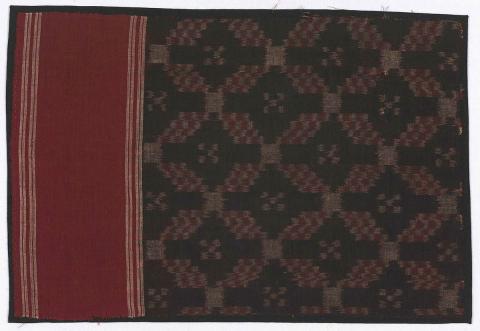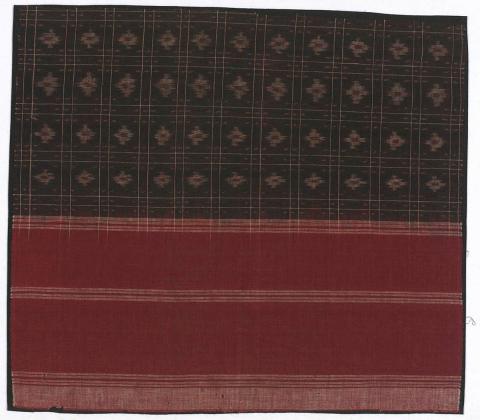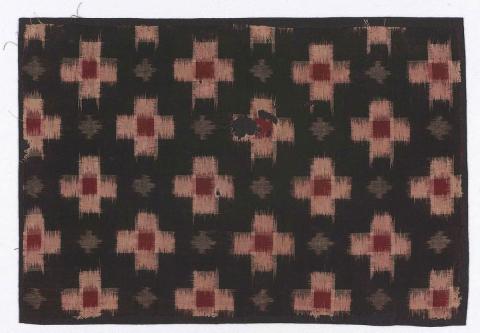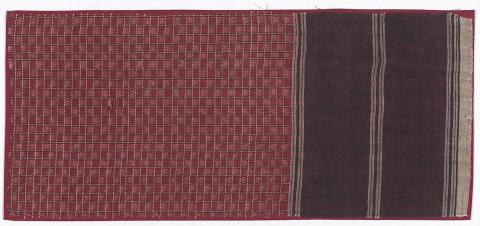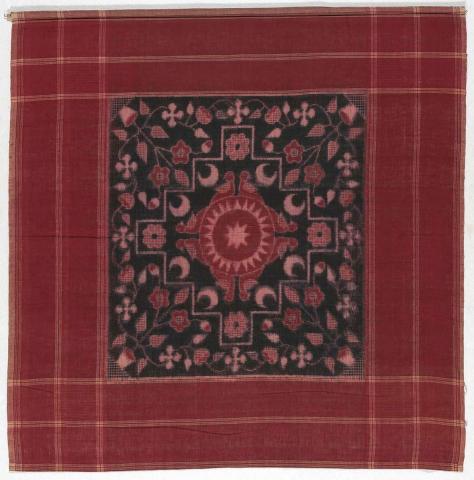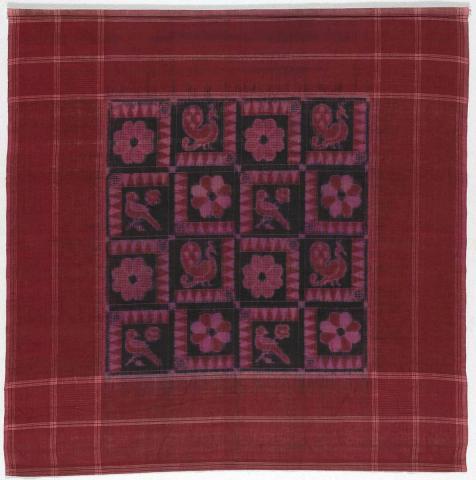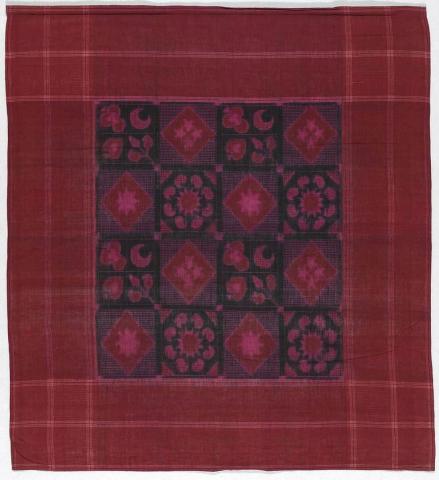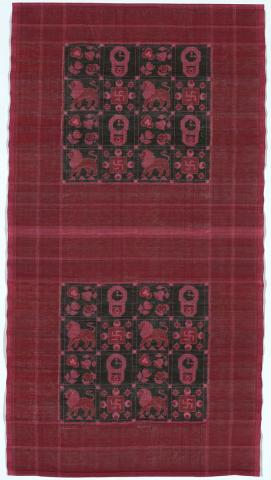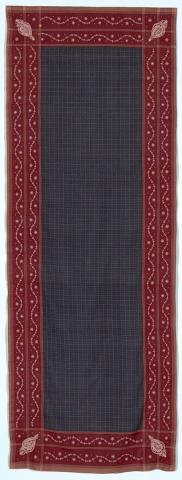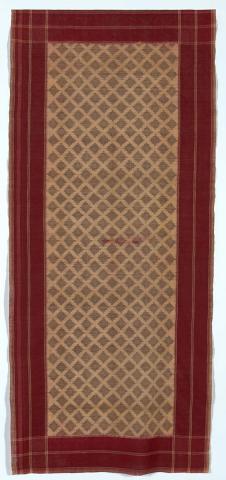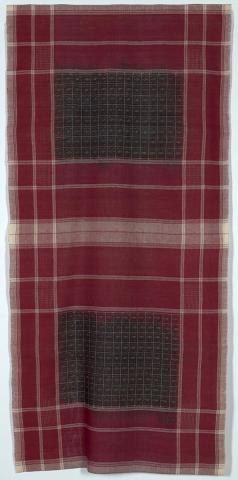ESSAY: Telia rumal textiles
By Tarun Nagesh
Artlines | 2/3-2020 |
A focused collection of works in a rare Indian textile tradition, recently donated to the Gallery by Dana McCown, documents the journey of a fascinating artform, writes Tarun Nagesh.
Along with Japan and Indonesia, India is one of the few places in the world where double ikat is made. The complex and laborious process involved in its production has rendered such work relatively rare, even among the thriving textile industries of the Indian subcontinent. A group of 18 exquisitely woven textiles recently acquired for the Collection exemplify the highly sophisticated tradition of telia rumal from the south-eastern Indian state of Andhra Pradesh.
Telia rumal derives from the words ‘tel’, meaning oil, relating to the alizarin dye process involving extensive oil treatment; and ‘rumal’ meaning square or kerchief, relating to the use of a one-metre square of fine cotton.1 In Persian, rumal also conveys the act of wiping one’s face, relating to a ritual cloth with which Hindu idols were cleaned.2
The coastal city of Chirala in Andhra Pradesh, has been a textile centre since at least medieval times, at one stage supplied cotton rumal for trade to Arab countries, and is thought to be where this particular form of weaving began. More recently, the tradition has spread to the towns of Puttapaka and Ponchampalli, where some of the few remaining artisans and weaving centres still exist and continue to produce telia rumal textiles. The tradition requires great skill and painstaking control throughout a time-consuming process, where the preparation of the yarn and dyeing alone takes several weeks before the complex weaving process can begin.3
This gifted collection includes both historical and recent works. Early examples are based on a simple grid, informed by the common gridded design of the Madras cloth or handkerchief. These were often punctuated with small squares, crosses and dots, and a supplementary weft was commonly added to the squares, which appear in the corner borders of the overall design. Embroidery of real gold thread or silk yarn was often added to these designs at a later stage, and they were purchased in pairs by wealthy Muslim women for dupattas (shawls). More recent works show complex pictorial motifs, which commonly include animal forms relating to Hindu gods, such as lions and peacocks, along with other forms of religious significance created for both Hindu and Muslim markets. By the 1920s, master weavers in Chirala had refined their skills and could execute complicated forms within the geometric layouts. Everyday objects also became part of the weavers’ repertoires, requiring an elaborate process to create curved lines.4
Several modern Master Weavers are also represented in this group of works, with examples by the late Chiluveru Ramalingum, Gunti Bhasker Rao and G Ramulu, along with those by members of the Gajam family, who have lived in Puttapaka for the last 100 years and have continued to create and adapt the telia rumal for contemporary markets. The most significant work is an enormous 100-motif cloth by present-day Master Weaver Gajam Govardhana, which won the artist a prestigious Padma Shri Award in 2001 (awarded by the Indian government): due to its great scale and complexity, the work can be considered a modern-day masterpiece of Indian textile design.
These works have been generously donated to the Gallery by Dana McCown, a well-known Indian textile specialist in Australia and world-renowned for her research on the telia rumal tradition. Her expertise is captured in this collection, having worked closely with artists to develop it over the course of more than 25 years.
Tarun Nagesh is Curator, Asian Art.
Endnotes
- A Buhler and E Fischer, Double Ikats of Gujarat, vol.1, AG Krebs, Basel, 1980, p.145.
- Dana McCown, An Endangered Species: Telia Rumal: Double Ikats of South India (published in conjunction with an exhibition at Toowoomba Regional Art Gallery, 27 June – 29 July 2001), Toowoomba Regional Art Gallery, 2001, p.11.
- McCown, p.13.
- McCown, p.17.
Connected objects

Shawl 1999
- GAJAM FAMILY - Family
- GAJAM Govardhana - Designer

100 motif telia rumal 2011
- GAJAM Govardhana - Creator

Sari 1999
- PUTTAPAKA WEAVER - Creator

His master's voice c.1970s
- GAJAM Ramulu - Creator

Geometric rumal 1997
- RAMALINGUM, Chiluveru - Creator

Diagonal telia rumal 1999
- BHASKAR RAO, Gunti - Creator
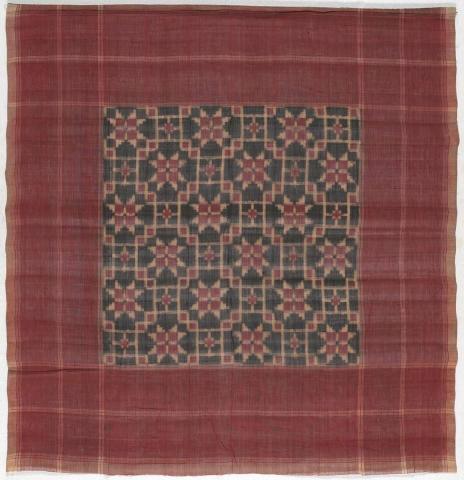
Telia rumal 1999
- GAJAM Ramulu - Creator
